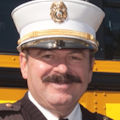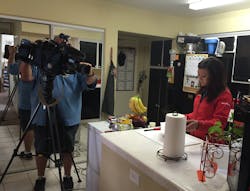We all know that cooking fires make Thanksgiving one of the busiest days of the year for the fire service. But there are several annual events that could warrant widespread exposure by a department PIO, trying to saturate the media with a fire safety message. Consider Easter, July 4 or even Mardi Gras or the Super Bowl, when people are inviting guests over for dinner parties or celebrations.
We also all know that one way to save lives and property is to prevent fires from occurring before they can do any damage. With this in mind, prior to last Thanksgiving, the Las Vegas Fire & Rescue Public Education & Information Officer (PEIO) conducted a media blitz to educate the public about fire and carbon monoxide (CO) safety. I’d like to share with you the media event we held as a jumping off point for developing your own event—one that is tailored to your community and the event you want to get in front of from a safety standpoint.
You’re cordially invited
The media was invited to the PEIO’s home for demonstrations and safety information offered by fire personnel. The house was available to the media for seven hours, with one hour for each media outlet. The PEIO set up four prop/demonstration areas. The kitchen was used to demonstrate cooking safety, smoke and CO alarms, and candle safety, and the living room was used to demonstrate fireplace safety. The media members were taken to each area and given an explanation of the safety lesson, much of which was done on camera as part of an interview.
The kitchen area was used to demonstrate a pan fire using live fire and how a pan cover can be used to put the fire out. Fire personnel then offered tips about pan fires, including instructions to not move the pan, and that a fire extinguisher (not water) should be used to put out a grease or liquid fire. Oven fires were also covered.
Additionally, smoke and CO alarms were set up on a kitchen counter, with several types of alarms on display, including one installed in the kitchen to show it in use.
Fire personnel also demonstrated candle safety using an actual candle with a flame and an LED candle on display. Candle safety rules were covered along with a demonstration of a piece of paper getting too close to the candle.
Moving to the living room, fire personnel reviewed fireplace safety, the different types of fireplaces used in Las Vegas, how people can check to see which type of fireplace they have, how to use their fireplace properly, and how to safely dispose of ashes.
The demonstration portion of the tour took about 30 minutes. Members of the media were then permitted to go back to any of the areas to redo camera shots, conduct demonstrations of their own or do “stand-ups,” which is when the reporter appears in front of the camera to narrate part of a story—most often at the beginning to set up the story, or at the very end. This took about 20–30 minutes.
When time permitted, fire service personnel also conducted interviews by phone for radio stations and the print media. The media used the demo videos and audio for two days on several newscasts at different times of the day. Some outlets even went back to the station and produced different variations of their own demos. The bottom line: There were many safety messages being provided by the various media just prior to the holiday. There was complete saturation.
The end result was there were no cooking fires in the city during the holiday. As a matter of fact, there were no serious fires throughout the entire viewing area, which covered approximately 8,000 square miles and nearly 2 million people. And there were no reported CO incidents in the city either.
Safety focused
The media is always interested in covering safety-related events. What they need is the expertise and the demonstrations to help deliver the message. This should be provided by the PIO. To make it interesting, it has to be visual and informative. Adequate safety precautions must be put in place to ensure that your demonstrations don’t become the main news story. Don’t forget to provide handouts and bullet sheets with safety tips and other useful information to help the reporter complete their story.
Teaching people how to be fire safe can prevent fires and keep your community safe. The PIO can accomplish that in many ways by working with the media ahead of the event or holiday.
About the Author

Timothy Szymanski
Timothy R. Szymanski is a Master Public Information Officer who is the fire public education & information officer for Las Vegas Fire & Rescue. He has been in the fire service for 51 years and has worked in every position from firefighter/paramedic to fire chief in his career. Szymanski also is a Master Fire Service Instructor. He was inducted into the Nevada Broadcasters Association Hall of Fame in 2017 and received the association’s Community Service Award. Szymanski also received the National Firemark Award from Liberty Mutual Insurance. He is a PIO instructor for the Nevada Department of Public Safety and was the Fire & Emergency PIO for the 1996 Summer Olympics in Atlanta.
